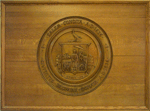Dow, George Francis: Difference between revisions
No edit summary |
No edit summary |
||
| Line 10: | Line 10: | ||
He was director of Essex Institute and editor of its publications. He also edited the four volume "Diary of William Bentley". | He was director of Essex Institute and editor of its publications. He also edited the four volume "Diary of William Bentley". | ||
He wrote many non-fiction titles including books on Pirates, Whaling, and Arts & Crafts of New England. | |||
He married Alice G. Waters in 1920, for many years librarian of the Essex Institute. | He married Alice G. Waters in 1920, for many years librarian of the Essex Institute. | ||
Revision as of 10:14, 2 June 2022
George Francis Dow (Jan.7,1868-June 5, 1936) was a leading New England historian and antiquarian who was instrumental in two Salem projects,
the moving of first period house the "John Ward House" and the creation of Pioneer Village for the 300th Anniversary of the founding of Salem.
Joseph Everett Chandler, an architect, and Dow conceived Pioneer Village a a means to demonstrate life in 1630. Noted landscape architect Harlan Page Kelsey drew up the plan.
Philip Horton Smith planned the restoration of the Ruck House. They created one of American's first living history museums.
Dow was a member of the Massachusetts Historical Society, the New England Historic Genealogical Society and many other history societies.
He was director of Essex Institute and editor of its publications. He also edited the four volume "Diary of William Bentley".
He wrote many non-fiction titles including books on Pirates, Whaling, and Arts & Crafts of New England.
He married Alice G. Waters in 1920, for many years librarian of the Essex Institute.
Another important project for Dow was the restoration of the Parson Capen House in Topsfield in 1913.
See Also
Obituary of George Francis Dow American Antiquarian Society
